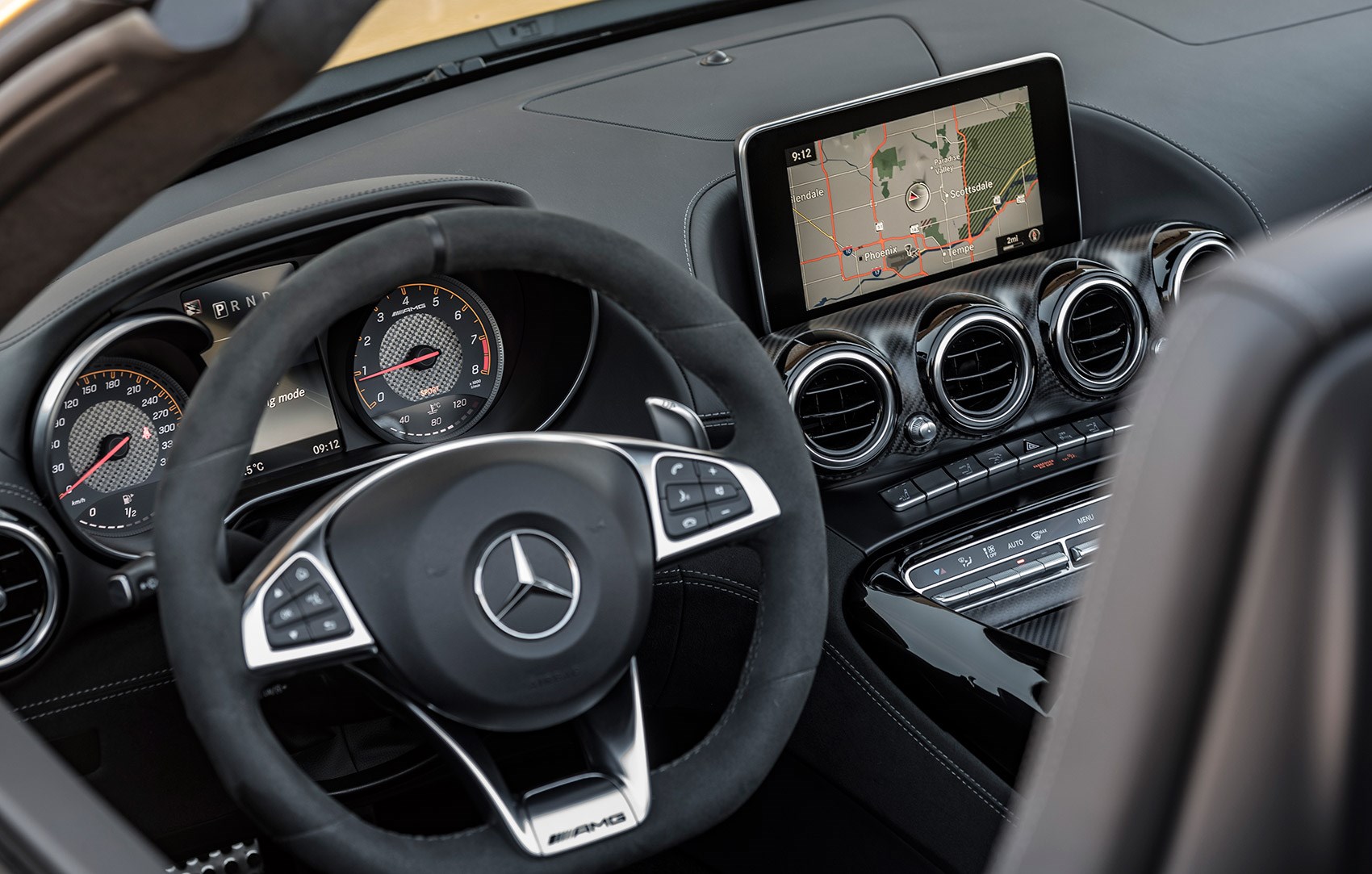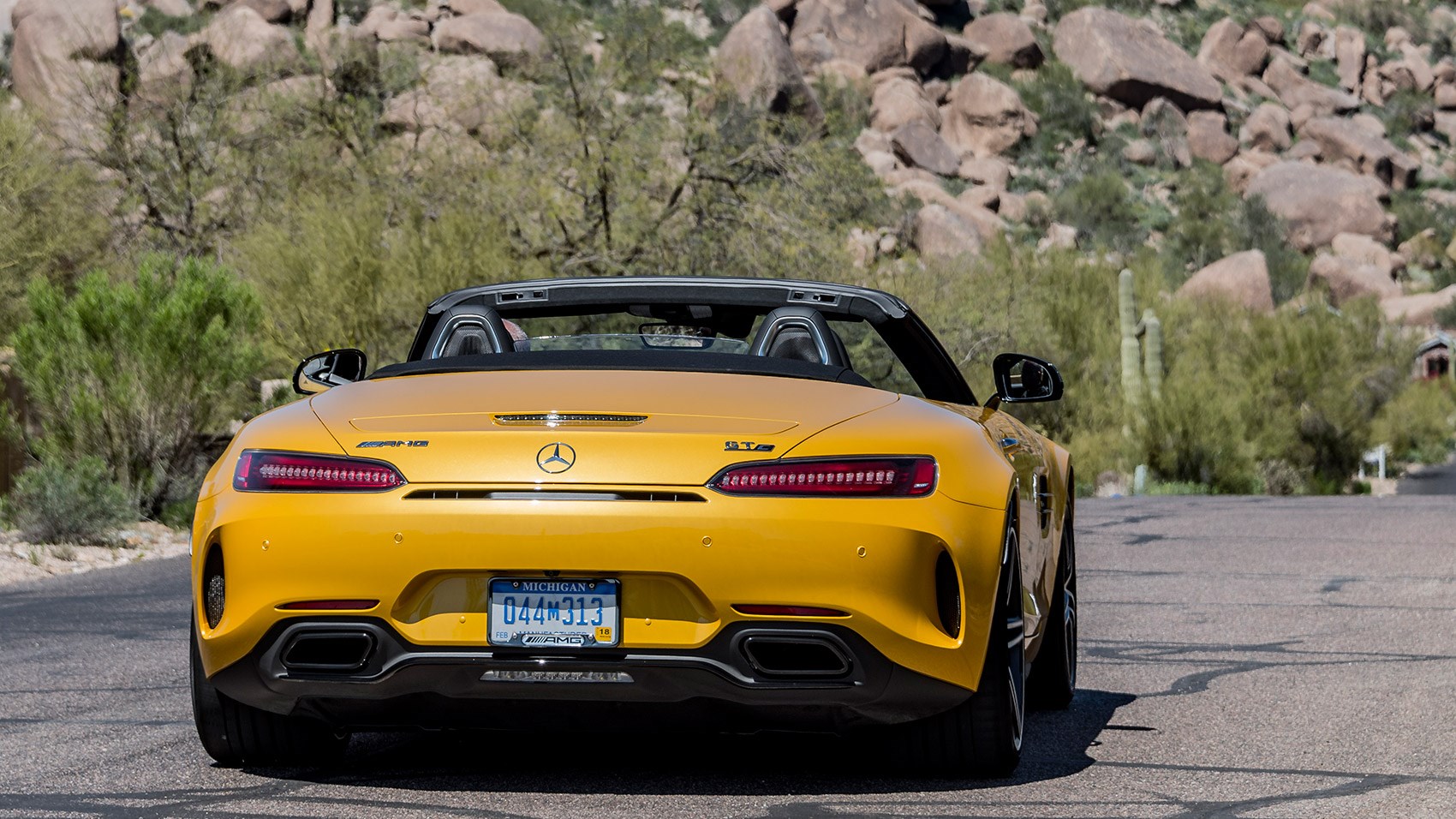► New drop-top AMG-GT C review
► 4.0-litre V8 packs 549bhp, 501lb ft
► Rear-wheel steering, 0-62mph in 3.7sec
When creating the Roadster version of the AMG GT, those lovable scamps at Affalterbach clearly wanted to avoid any accusations they’d gone a bit soft.
For while there is a regular entry-level variant essentially similar to the base spec of the AMG-GT coupe range, instead of pairing that with a mildly more powerful GT S version, Mercedes-AMG is launching the drop-top with a new 549bhp GT C model.
The C does not stand for convertible. In fact, the official explanation is that it doesn’t stand for anything – seriously, how un-German is that? – but we’re going to go ahead and suggest you might want to think that it stands for carnivorous.
With its gaping grilles and wide-body rear borrowed directly from the hardcore GT R coupe range-topper, this thing looks hungry. And no prizes for guessing it’s got an appetite for Porsche…
What makes an AMG GT C a GT C?
The chromed-up, 15 bar ‘Panamericana’ grille – borrowed from the racing cars – is now standard on all versions of the AMG GT, but in this instance looks unnervingly like someone’s tried to cage off its gaping maw for public safety.

The GT C may have lost a roof but it’s gained an attitude. Those wide hips accentuate the sense of purpose in its stance, and if it wasn’t for the slightly unseemly number of additional vents and openings, we’d have no compunction about declaring this the best-looking AMG GT variant yet.
The Roadster bodystyle seems to suit this model, taking some of the weight out of the Coupe’s design, leaving a louche, lithe and positively menacing-looking machine that no-one is going to accuse of being the less-committed option.
Mercedes-AMG GT Coupe vs Porsche 911 twin test
Goes as hard as it looks, right?
Compared to the standard GT Roadster, the GT C gains 80bhp, sees torque increase to 501lb ft from 465lb ft, and at an official 3.7sec accelerates over the 0-62mph benchmark 0.3sec faster. Top speed also rises 8mph to 196mph, should that be relevant.
Both models use AMG’s 4.0-litre twin-turbo V8, with the ‘hot inside V’ configuration that mounts said turbos between the cylinder banks for improved response. Both do indeed have ridiculously good throttle reaction for forced-induction motors, and the regular model isn’t exactly lacking in motivational spirit.

Floor that throttle in the GT C, however, and you’ll immediately understand where your extra money went. It’s not super-supercar fast, but it’s bloody close, and the experience of moving in space without apparently troubling time is overlaid with a dramatically hard-edged V8 sound accompanied by laugh-out-loud noises from the turbos.
No other car sounds so much like there’s an owl trapped under the bonnet when you back off the accelerator – a slight but distinct hoo-hoo (or possibly even woohoo! as it seems to be having a good time) that never ceased making us smile. You don’t get so much of this in the regular model, which probably tells you where AMG found those extra horses.
There’s plenty of snap, crackle and pop from the exhausts, too, depending on the driving mode – GT C offers Comfort, Sport, Sport Plus and Race settings – but it’s the turbo noise that sets the tone here.
This instant-added freneticism is perfectly matched to the overall character of the GT C, which doesn’t just look dosed-up with the GT R’s muscle formula, but also borrows the end-of-level bruiser’s active rear-wheel steering.
So the Mercedes-AMG GT C handles, too?
Like all rear-wheel steering systems, this works by effectively shortening the wheelbase in tighter turns by steering the rear wheels in the opposite direction to the fronts, then pseudo-lengthening it by steering the rear wheels in the same direction as the fronts during faster turns, increasing stability.

And like all rear-wheel steering systems, it takes a bit of getting used to. Impressively calibrated though it is, steering reaction obviously isn’t 100% consistent, and if you’re on the cusp of the change-over point between rear axle behaviour – 62mph – sometimes the amount of lock you’re applying requires minute adjustment.
Especially since the GT C – which also features an electronically-controlled limited slip differential – generates an enormous amount of grip, meaning there are a lot of corners it can take at around 62mph as a result.
Because of this, there’s an argument to be made that the ordinary GT Roadster, with its conventional rear axle and mechanical LSD, is the purer driving experience – and in no sense is that car short of agility.
But the first time you feel the GT C properly pivot around you as you throw it into a switchback you’ll forgive the RWS its occasional foibles absolutely. It turns what is an undeniably big, 1735kg car into a mildly-steroidal ballet dancer: exceptionally graceful, yet with the muscle to have more outrageous fun.
Can it conquer continents in a single bound?
An important element in the GT Roadster’s success – in terms of both handling and comfort – is the structure.
With a mix of aluminium, steel, magnesium and composite, plus a front-mid engine location, this is a structurally stiff and well-balanced car. The additional reinforcement made to compensate for the loss of the solid roof panel does an excellent job, too, as this has to be one of the least flexy high-performance convertibles we’ve ever experienced.

This strength allows the suspension to do its job properly. You get three-stage adaptive damping as standard on the GT C, and judging by the way this behaves as an optional extra on the GT, leave the chassis at this and you’ll have yourself a comfortable grand tourer that seems to magic away bumps while staying blissfully flat through the corners.
I’m sensing a but…
Our test car had the optional Dynamic Plus package, which adds active engine mounts and firmer suspension tuning. Wouldn’t say this is untenable, but it delivers a lot more road noise and surface shock through to the cabin, and honestly the regular adaptive setup is hardly wanting for poise.
Similarly, the optional carbon-ceramic brakes feel far from essential, with an irksome grabbyness at low speeds. Only bother if you’re addicted to track days.
It’s pleasing to report that AMG’s seven-cog Speedshift transmission seems better than ever, mind, with almost zero down-change refusals during hard driving. It can still get jammed up if you mis-time an upshift at the redline, but we’ve come to find this an endearing commentary on our own inadequacies rather than a frustration.
How’s the interior? And the roof?
Beguiling and bemusing in one. It looks good and feels quality, but that monster centre console has awkwardly placed buttons that remain an ergonomic travesty, and both GT Roadsters we drove on the launch were plagued by minor but irritating rattles. Not what you want in a £140k car.

The roof is impressive. Three-layer construction gives great refinement, it opens or closes in just 11 seconds, and you can operate it at up to 30mph.
That said, rear visibility is somewhat limited by the deck height – the GT Roadster has got some serious booty – which together with the high door line can make you feel as if you’re luxuriating in a leather-line bathtub.
Still, you get stacks of standard kit in the GT C – including COMAND Online sat-nav infotainment, Burmester hifi, heated seats and Airscarf – and there’s a vast amount of adjustment in the steering wheel and seating position, so it’s easy to get comfy.
Verdict
The AMG GT C Roadster is not a subtle car. But it’s got way more charisma than a 911 Turbo S, and costs a useful chunk less. If you like an all-seasons tan and want to travel in a hurry, we can think of few better ways of spending this amount of cash.
More Mercedes-Benz reviews by CAR magazine